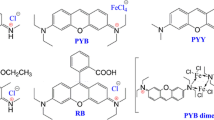Abstract
The deprotonation of dibenzofluorescein (DBFL), a long wavelength fluorescence probe, results in the simultaneous occurrence of neutral form, monoanion and dianion under physiological conditions. The fluorescence properties of the former two cannot be measured directly because they are always coexistent with some other species. By measuring the fluorescence under various pHs we computed the fluorescence parameters for each species involved in the prototropic equilibria of DBFL, including each species’ emission spectrum, excitation spectrum, emission and excitation maximum, fluorescence quantum yield and lifetime. It was found that the monoanion is the most fluorescent chromospheres (Φ f = 0.66, compared to Φ f = 0.25 for dianion, 0.18 for cation and 0.0 for the neutral form). Together with the computed pK as, we are able to suggest that the monoanion plays a major role under physiological conditions when DBFL is used as a fluorescence probe, contrary to the assumption in literature.






Similar content being viewed by others
References
Kuhn MA, Haugland RP (1993) U. S. Patent 5516864
Lee LG, Connell CR, Woo SL, Cheng RD, McArdle BF, Fuller CW, Halloran ND, Wilson RK (1992) DNA sequencing with dye-labeled terminators and T7 DNA polymerase: effect of dyes and dNTPs on incorporation of dye-terminators and probability analysis of termination fragments. Nucleic Acids Res 20:2471–2483
Kempe T (2003) U. S. Patent 6534646
Lee LG (1990) U. S. Patent 4933471
Diwu Z, Haugland RP (1997) U. S. Patent 5773236
Liu J, Diwu Z, Leung W-Y (2001) Synthesis and photophysical properties of new fluorinated benzo[c]xanthene dyes as intracellular pH indicators. Bioorg Med Chem Lett 11:2903–2905
Gómez-Hens A, Aguilar-Caballos MP (2006) Long-wavelength fluorophores—new trends in their analytical use. TrAC Trends Anal Chem 23:127–136
Thomas KJ, Sherman DB, Amiss TJ, Andaluz SA, Pitner JB (2006) A Long-Wavelength Fluorescent Glucose Biosensor Based on Bioconjugates of Galactose/Glucose Binding Protein and Nile Red Derivatives. Diabetes Technol Ther 8:261–268
Lee LG, Berry GM, Chen C-H (1989) Vita blue: a new 633-nm excitable fluorescent dye for cell analysis. Cytometry 10:151–164
Zhang H, Zhou Y, Zhang M, Shen T, Li Y, Zhu D (2003) Photoinduced interaction between fluorescein ester derivatives and CdS colloid. J Colloid Interface Sci 264(1):290–295
Zhang H, Zhou Y, Zhang M, Shen T, Li Y, Zhu D (2002) Photoinduced charge separation across colloidal TiO2 and fluorescein derivatives. J Phys Chem B 106(37):9597–9603
Diehl H (1989) absorbance of the various prototropic forms of yellow fluorescein in aqueous solution. Talanta 36:413–415
Diehl H, Horchak-Morris N (1987) The absorbance of fluorescein in the ultraviolet, as a function of pH. Talanta 34:739–741
Song A, Zhang J, Zhang M, Shen T, Tang JA (2000) Spectral properties and structure of fluorescein and its alkyl derivatives in micelles. Colloids Surf A 167:253–262
Jang YH, Hwang S, Chung FS (2001) Tautomeric equilibrium of fluorescein in solution: ab initio calculations. Chem Lett 12:1316–1317
Hungerford G, Benesch J, Mano JF, Reis RL (2007) Effect of the labelling ratio on the photophysics of fluorescein isothiocyanate (FITC) conjugated to bovine serum albumin. Photochem Photobiol Sci 7:152–158
Rodriguez HB, Lagorio MG, Román ES (2004) Rose Bengal adsorbed on microgranular cellulose: evidence on fluorescent dimers. Photochem Photobiol Sci 2:674–680
Zhang X-F, Liu Q, Song A (2008) Tautomeric and prototropic equilibria of dibenzofluorescein in solution. Photochem Photobiol Sci (in press)
Tanaka K, Miura T, Umezawa N, Urano Y, Kikuchi K, Higuchi T, Nagano T (2001) Rational design of fluorescein-based fluorescence probes. Mechanism-based design of a maximum fluorescence probe for singlet oxygen. J Am Chem Soc 123:2530–2536
Acknowledgements
We thank the Key Laboratory of Photochemistry, Chinese Academy of Sciences for the financial support.
Author information
Authors and Affiliations
Corresponding author
Rights and permissions
About this article
Cite this article
Zhang, XF., Liu, Q., Son, A. et al. Fluorescence Properties of Dibenzofluorescein in Aqueous Solution. J Fluoresc 18, 1051–1057 (2008). https://doi.org/10.1007/s10895-008-0349-7
Received:
Accepted:
Published:
Issue Date:
DOI: https://doi.org/10.1007/s10895-008-0349-7



